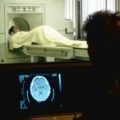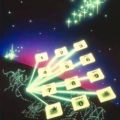
Recent research claims that playing video games improves some types of visual functioning. But before rushing to your computer or buying more games, consider another new research finding. Newly published results suggests that performing an exciting video display terminal task fitted with a bright display suppresses the nocturnal changes in melatonin concentration and other elements of our biological clocks. In other words, playing an exciting video game at night with a bright display backlight might just be the physiological cause of a poor night’s sleep.
Melatonin secretion is linked to both the sleep-wakefulness and light-dark cycles. Ocular perception that ambient light is dimming has been shown to trigger, via neural pathways involving the hypothalamus, increased secretion of melatonin by the pineal gland. Serum levels increase 10-fold just before sleep and peak around midnight. Twenty-four-hour secretion is higher in winter than in summer. The decline of melatonin secretion with age has been blamed for the tendency to insomnia in the elderly.
Another factor affecting the human biological clock and sleep-wake cycle is thought to be increased mental activity caused by using a computer. It has been reported that melatonin level was influenced by exercise and affective state. It has also been reported that social activities entrained the circadian rhythm in humans.
In a new study, the effects of a BD and increased mental activity level on nocturnal melatonin level while subjects performed VDT tasks at night were examined. Salivary melatonin concentration in each subject was measured, as well as rectal temperature (a physiological marker of circadian rhythm that is influenced by exposure to bright light). Additionally, heart rate and an EEG were monitored to evaluate the activity levels of autonomic and central nervous systems, respectively.
“Effects of VDT Tasks with A Bright Display at Night on Melatonin, Core Temperature, Heart Rate, and Sleepiness” appeared in the May 2003 edition of the Journal of Applied Physiology.
Seven healthy male students, with a mean age of 24.7 5.6 (SD) years participated. None could be considered an extreme morning type or an extreme evening type. Beginning one week before the start of the experiment, the subjects were instructed to wake up between 0800 and 0900 and go to bed between midnight and 0100 to maintain regular sleep-wake cycles. The average times when the subjects went to bed and woke up were 0045 and 0816, respectively. Furthermore, beginning three days before the experiment, the subjects recorded their oral temperature approximately every three hours, except during sleep. The peak of the circadian rhythm of oral temperature was estimated.
The subjects performed exciting tasks on a VDT with BD (exciting-BD) and dark display (exciting-DD) and boring tasks on a VDT with BD (boring-BD) and DD (boring-DD) between 2300 and 0200 the next day. The experimental order was randomized, and the interval of each experiment was one week. The exciting task was a shooting game, and the boring task was a simple addition task. The subjects were instructed to gaze at the display during the task. If a subject did not respond because he closed his eyes, an alarm rang and the number was counted. The 17-inch color-display was placed at eye level 45 cm in front of the subject. The screen of the display was 240 mm long and 325 mm wide. The screen of the BD was white with 120 cd/m2, and the screen of the DD was black with 0.5 cd/m2. The vertical light intensities of the BD and DD were 45 and 15 lx at each subject’s eye level, respectively.
Saliva samples were collected by using cotton wool and a plastic tube at 2300 (before commencement of the task) and at 0200 (after completion of the task). Rectal temperature was recorded at two-minute intervals during each task. Heart rate, EEG, and subjectively rated sleepiness were recorded before the start of each task and every hour while the subjects rested between tasks. The EEG was recorded at the central location for three minutes while the subjects closed their eyes with the use of a bioelectric amplifier.
The salivary melatonin concentration increased at 0200 in all conditions. The salivary melatonin concentration was significantly influenced by the brightness of the display and significantly lower during the exciting-BD than during the exciting-DD. However, there was no significant difference between salivary melatonin concentrations during the boring-BD and boring-DD.
The rectal temperature decreased during the night in all conditions. The rectal temperature was higher during the exciting task than during the boring one and significantly higher during the tasks with a BD than during the tasks with a DD in the latter half of each task.
Significant effects of the task and time course on subjectively rated sleepiness, relative theta power, and heart rate were found. The subjectively rated sleepiness and relative theta power increased during the task in all conditions. The subjectively rated sleepiness and relative theta power were higher during the boring VDT task than during the exciting one. No significant effects of BD on subjectively rated sleepiness and relative theta power were found. The heart rate decreased during the task in all conditions. The heart rate was significantly lower during the boring VDT task than during the exciting one. Although no significant effect of BD on heart rate was found, heart rate tended to be higher with the BD than with the DD.
Some observational studies have demonstrated that exposure to an electromagnetic field (EMF) suppressed melatonin level in humans, but this was not found in some laboratory studies carried out under carefully controlled experimental conditions. Because the intensity of the EMF from a BD is much lower than that used in these laboratory studies, it is thought that the EMF from the BD had little effect on melatonin level. In conclusion, performing an exciting VDT task with a BD influences the nocturnal melatonin concentration and other physiological indicators of the human biological clock.
These results do not dispute the findings that video games offer increased visual acuity to the user. Instead, the Japanese study suggests that there is an unexpected price for turning on the computer late at night for high tech excitement. The old standby of a cup of warm milk before bed may be the best advice, after all.


















Comments are closed.